Pulitzer Center Update June 10, 2019
Beyond Religion Conference Highlights
Country:

“My work is about places of uncertain identities, where the sacred can transcend borders,” said Polish photojournalist grantee Monika Bulaj, her voice resounding through an audience of more than 200 journalists, activists, policymakers and educators. The screen behind her featured her black and white photography, capturing portraits of women and displaced peoples in Africa, Asia and the Middle East. “I look for the beauty even in those wartorn countries. I look for the solidarity of the oppressed,” she continued.
The Pulitzer Center’s Beyond Religion Conference, held June 8 and 9, 2019, at the National Press Club in Washington, D.C, focused on the role of religion in journalism. Throughout the six panels and two workshops over Saturday and Sunday, panelists explored the intersection of religion with climate change, global health, conflict and peacebuilding, gender rights, fundamentalism, and more.
The opening day of the conference focused on the role of religion in peacebuilding, gender, fundamentalism, science and the environment. Panelists reflected on the complexity of religious practice and the dangers of universalizing across a religious group. They explored credibility in peacebuilding, and how religion can shape our notion of reality. Saturday evening’s dinner allowed a deeper glimpse into a few Pulitzer Center grantees’ varied projects on religion, including Bulaj’s. On Sunday, attendees participated in conversational workshops with the panelists on the evolution of the religion beat and the coverage of American Muslim communities by the media.
Beyond Religion, and the Pulitzer Center’s reporting on religion and outreach is supported by the Henry Luce Foundation. Support for conference-related activities also comes from Georgetown University's Berkley Center for Religion, Peace, and World Affairs, a Campus Consortium partner. The Berkley Center is dedicated to the interdisciplinary study of religion, ethics, and public life.
During the conference, our hashtag, #PulitzerBeyondReligion, became a trending topic in the D.C. area.
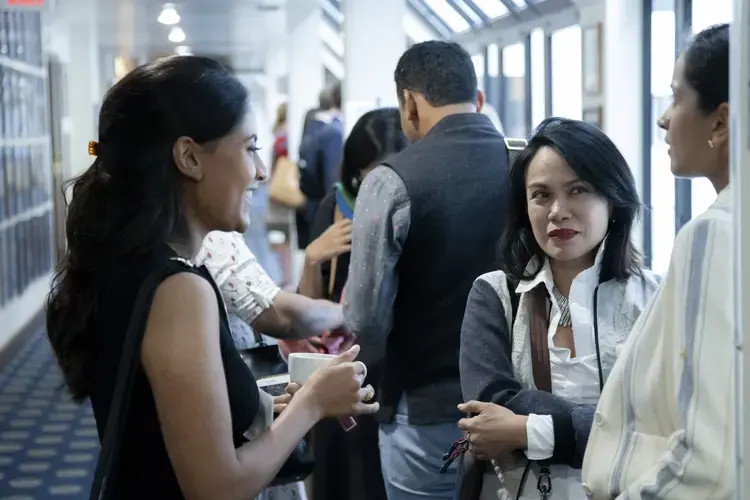
Panel 1: The Role of Religion in Building Peace
What role does religion play in fostering peace? In Nigeria, as panelist Oge Onubogo, senior program officer for Africa Programs at the United States Institute of Peace, explained, religious leaders collaborate on interfaith approaches to conflict. Grantee Danny Gold shared his experiences reporting on the rehabilitation of gangs in El Salvador through religion.
Panelists focused the complexity of religion, and how “it is never solely benign and never solely evil,” according to British journalist grantee Cathy Otten, who reported on Yezidi women facing ISIS. She expanded that people sometimes commit violent acts, believing they are bringing about peace.
Panelists confronted the intersectionality of gender and religion in Northern Ireland, the Philippines, Saudi Arabia, and India. How are women’s roles in Saudi Arabia shaped by religion and politics, and how are these roles evolving? How do LGBT people in India understand their own gender and sexuality as it relates to religious practice?
Journalist grantee Sarah Aziza investigated the progressive claims of Saudi Crown Prince Mohammed bin Salman and the darker reality for many Saudi women. “It wasn’t a secret that this crowned prince was locking up women activists who campaigned for change for decades,” she said.
Ana Santos, another journalist grantee, spoke about the inequality that women face in the Philippines, and how she chose “to be angry and write.”
Discussing how media re-enforces stereotypes by asking certain questions related to gender. Headlines always a battlefield. #PulitzerBeyondReligion pic.twitter.com/4vy2Bj2blF
— Kem Sawyer (@kemsawyer) June 8, 2019
Panel 3: Religion and the Environment
Increasingly, the Catholic church is seeing a movement to address land use, biodiversity, and the rights of Indigenous people. Indigenous leaders from the Amazon and in the United States have voiced the importance of protecting the environments they have called home. Is there potential for interfaith collaboration in protecting our shared planet?
Panelist Mindahi Bastida Munoz, director of the Original Caretakers Program at the Center for Earth Ethics, spoke about biodiversity and Indigenous land. "Eighty percent of biodiversity in this world is found in Indigenous peoples' territories. This is not an accident. We don't take it for granted—it's a lot of work to care for."
“In the relational language of the Lakota, there is no word for domination.” @Tiokasin describes how old languages are inclusive, connected to the earth, and embody the new “heartset” needed for conversations about the environment today. #PulitzerBeyondReligion pic.twitter.com/Dpx4zAtclp
— Nora ML (@noradml17) June 8, 2019
Panel 4: Religion and Fundamentalism
From Iraq and Syria to Indonesia and the Balkans, to the United States and Europe, how do religion and fundamentalism intersect? What are the roots of ideologically-based violence? Panelists explored the differing coverage of extremism, fundamentalism, and violence across religious faiths.
“American media does use the word terrorism almost exclusively to refer to Muslims,” said Dalia Mogahed, director of research at Institute for Social Policy and Understanding (ISPU).
Panel 5: Faith and Civil Society
Religion has often guided civil society towards tolerance and justice, but what happens when it is used to foster intolerance? Panelists explored the intersection of faith and civil society in their work in Northern Ireland, Israel, and in Hindu communities in the United States.
Panelist Iris Zaki, another Pulitzer Center grantee, spoke about the settler movement in the Occupied Territories in Israel, the subject of her film Natural Born Settlers. She explored the experiences of young second generation individuals in the settlement. “People who were born there, it’s their home now. I think it complicates the discourse. I think it’s good to complicate things,” she said.
Packed house for the @pulitzercenter Beyond Religion conference panel on #faith and #CivilSociety featuring @amber_khan @IriSZakI @phillipWGBH and @Callum_Macrae pic.twitter.com/9CeZKIWZVN
— Evan Berry (@ecothought) June 8, 2019
In a live taping of her PRX podcast, On Being, Krista Tippett talked with Pulitzer Center grantee and science writer Erik Vance about his work and perspectives on the relationship between religion and science.
Vance said that people can bridge the gap between religion and science by acknowledging the validity of everyone’s realities, regardless of individual beliefs. "What is needed is empathy... Having empathy for where somebody is coming from or why they are having that experience, and that that experience is totally valid. And that people are not crazy. That people act rationally."
Evening Remarks and Special Readings
Pulitzer Center Managing Director Nathalie Applewhite opened Saturday evening’s dinner with remarks about the Pulitzer Center’s mission in raising awareness of the most pressing global issues of our time. “We’ve heard nuanced conversations from leading experts and journalists working around the world,” she said of the day’s panels.
Loved being part of @pulitzercenter's #BeyondReligion conference. Speaking alongside the inspiring Dalia Mogahed (@DMogahed), Sarah Topol (@satopol), and Ben Taub. Thank you Indira Lakshmanan (@Indira_L) for being such a thoughtful moderator. pic.twitter.com/EXfMpozOLl
— Amit Madheshiya (@amitmadheshiya) June 10, 2019
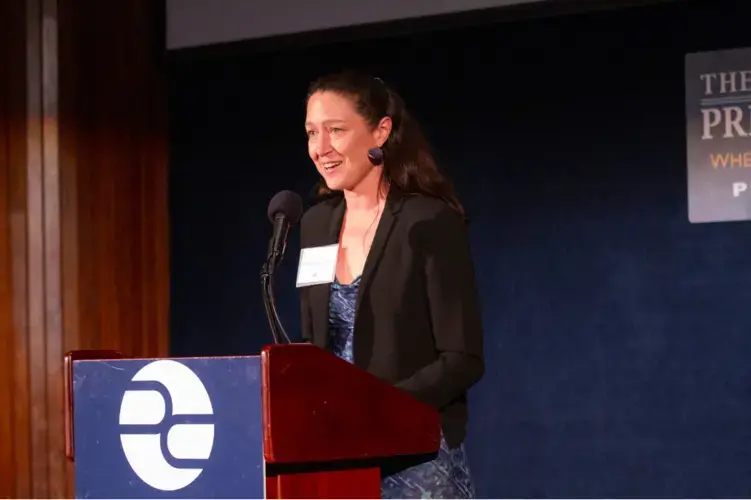
She then welcomed Executive Director Jon Sawyer to the stage, who introduced Michael Gilligan, president of the Henry Luce Foundation.
“Luce funding helped bring underreported tragedies to the attention of public attention and policy makers alike,” Sawyer said, referencing the Pulitzer-supported Associated Press reporting on the crisis in Yemen. The Pulitzer Center supported nearly 90 projects in the last six years, ranging from religion and family planning in Indonesia, to the deradicalization of extremism in Europe, to the role of religion in Saudi Arabia, to the leadership of buddhist monks in Cambodia. “For us, Luce has made possible the support of in-depth reporting around the world," Sawyer said.
The Luce Foundation also helped to catalyze the Pulitzer Center’s relationship with the Berkley Center, creating the first Campus Consortium with a specific focus on religious reporting.
“I’ve been looking forward to this opportunity to say congratulations to the Pulitzer Center for its amazing growth since 2006,” Gilligan said.
Gilligan thanked Sawyer and the Pulitzer Center for deepening understanding of issues “happening at the intersection of religion and international affairs."
“At this moment, when journalism is so challenged, and when journalists are at great risk, we’re grateful for the Pulitzer Center’s courageous work in fostering and inspiring first-rate work at this intersection and at this moment in our world.”
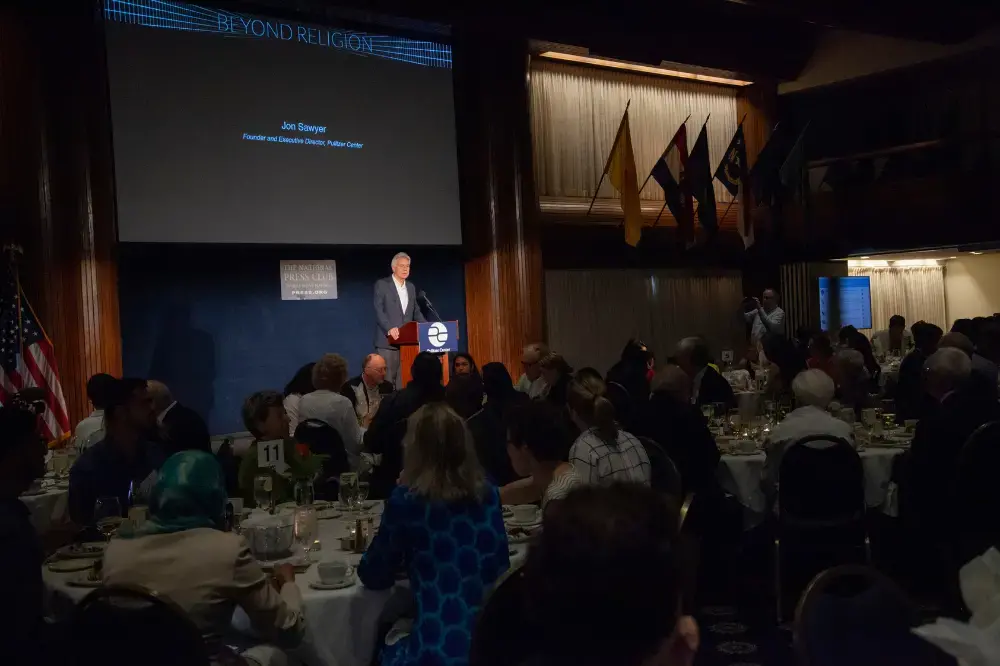



University and Community Outreach Director Ann Peters later spoke about the Pulitzer Center’s educational outreach programs, including the Campus Consortium network of 35 colleges and universities. “Our aim is to raise awareness at campuses across the U.S. on many of the issues we’ve been discussing today. But we don’t wait until college for these conversations to begin,” she said. The Pulitzer Center’s education team works with teaching partners, students at middle schools, high schools, and universities. With K-12 students, last year’s program reached more than 16,500 students with 460 events.
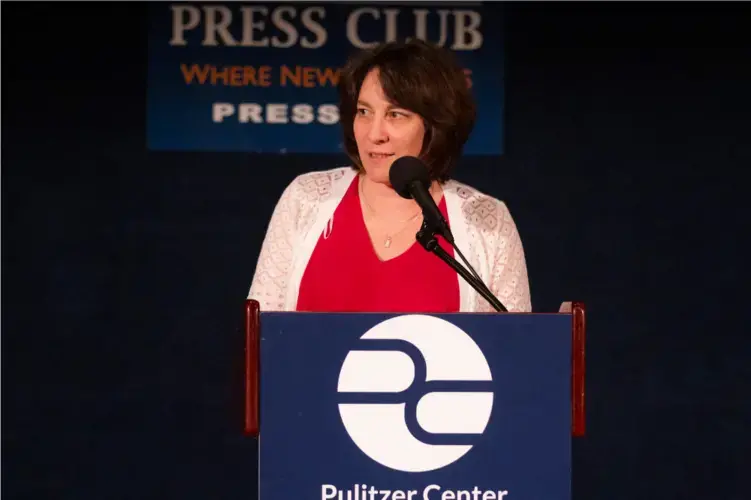
Peters turned the podium to Contributing Editor Kem Sawyer, who works with emerging journalists from the Campus Consortium network.
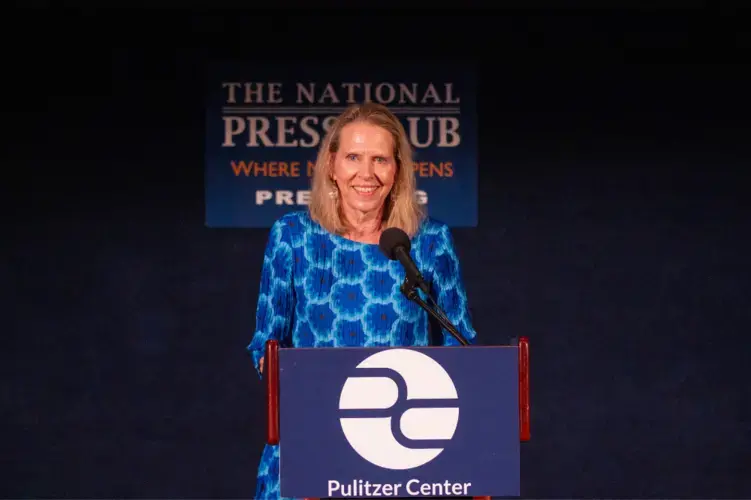
She described this year's Student Fellows. “We have selected an amazing group of Student Fellows this year—43 in number,” Sawyer said. “They are traveling to 29 countries, from Guyana to Bhutan and places in between.” Each student fellow is paired with a Pulitzer Center grantee who serves as an advisor. She also recognized the three winners of the Beyond Religion reporting competition for students and recent alums at Campus Consortium partners:
Catherine Cartier from Davidson College will report from Lebanon on collaborative religious efforts to promote conservation and preserve the country's cedar trees, one of Lebanon's most powerful and enduring symbols of national identity.
University of Chicago's Nikhil Mandalaparthy will examine Hindus and Muslims in South Asia who congregate together in shared religious spaces–called 'dargahs'.
Lily Moore-Eissenberg from Yale University will investigate the work of nuns who advocate for the rights of immigrants on the U.S. southern border.

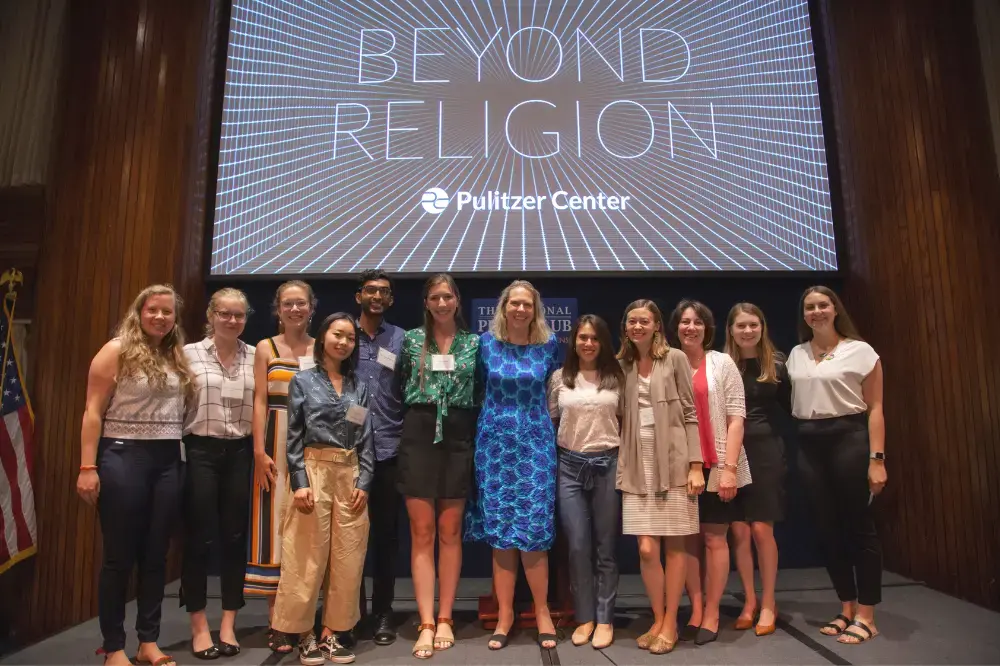


Next, Hannah Berk, education coordinator at Pulitzer Center, described the Beyond Religion Poetry Contest and this year’s winners. For this initiative, students respond to Pulitzer Center reporting through original poetry. “These students harness the power of language and demonstrate empathy,” they said. Each student used a photo as inspiration, considering how photography can tell a story. They announced the winners of this year’s contest:
Molly H. Rufus, 11th grade, Homeschooled, VA, inspired by Eloisa Lopez's photo in "The Filipino Catholic Church in Crisis" by Adam Willis
Beatrix Stone, 7th grade, Alice Deal Middle School, Washington, D.C., inspired by Eloisa Lopez's photo in "The Filipino Catholic Church in Crisis" by Adam Willis
Selam Weimer, 11th grade, Woodrow Wilson High School, Washington, D.C., inspired by Moises Saman's photo in "Iraq's Post-ISIS Campaign of Revenge" by Ben Taub
Stone and Weimer shared their poems on the stage. As they read, the images that inspired their poetry appeared on the screen behind them.
“Who would take love, faith, hope, and make it the enemy?” Stone asked, reading from her poem.
“The afterlife tastes of the ashes of deja-vu,” read Weimer, in a steady and somber voice.
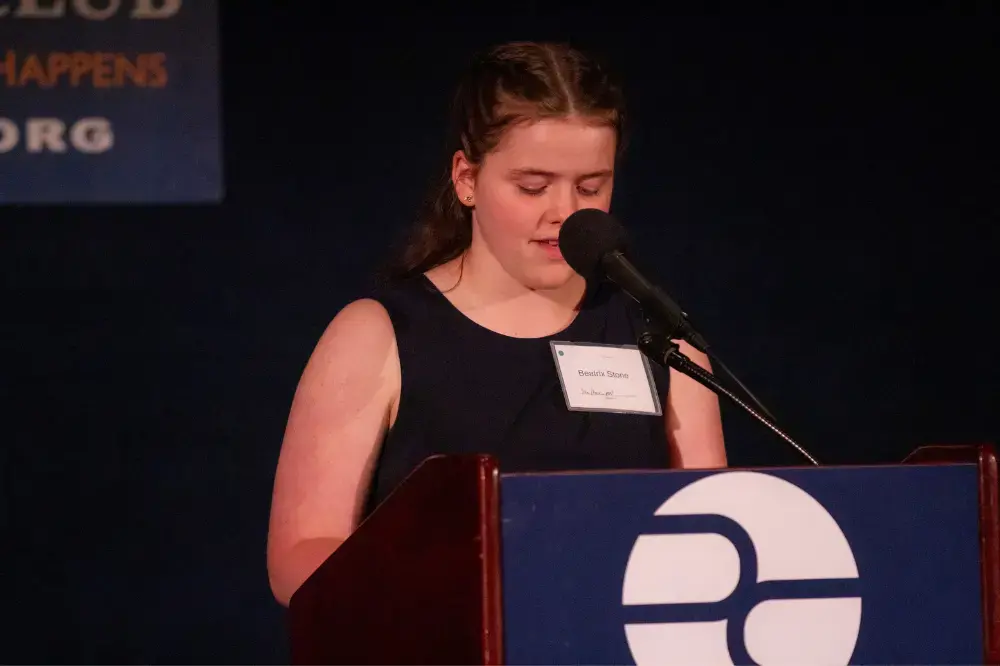
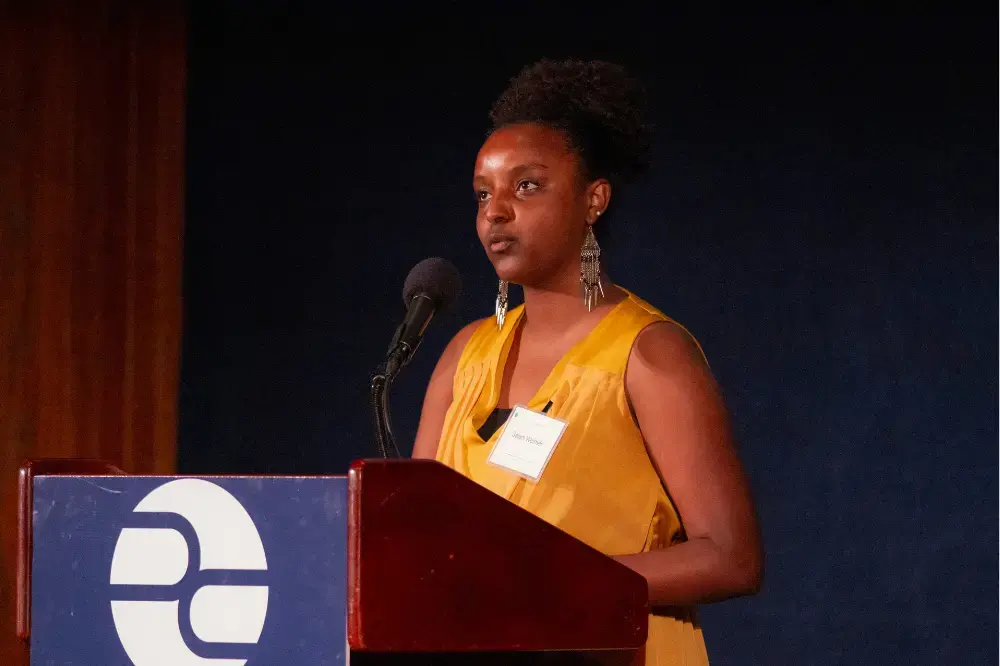


Fareed Mostoufi, senior education manager at Pulitzer Center, explained how students explore bringing issues uncovered in Pulitzer Center reporting into their own lives through hands-on digital storytelling workshops, photography exhibitions, film screenings, annual poetry and letter writing contests, and presentations by journalists in person and over Skype. “I’m reminded everyday that stories can be invaluable anchors in cultivating curiosity and compassion,” he said.
Speaking of a visit with photojournalist grantee Monika Bulaj to a D.C. jail, Mostoufi told of one writer who had pulled Bulaj aside to explain that she was also an artist and now saw that she could be a journalist.
Bulaj presented her photography along with a poetic string of words. “Perhaps a photographer can do nothing more than gather the pieces of a mosaic no one will ever finish,” she said. Her photographs, capturing the lives of minorities living in the Middle East, Asia, the Middle East, and Italy, lingered on the screen behind her. “In the Middle East, Africa and Asia, the richness of complexity is disappearing before our eyes, in lands where diverse peoples have cohabited and interacted for thousands of years,” she said.
She spoke of the process of traveling with and photographing the Tuareg people, a large Berber ethnic confederation inhabiting the Sahara. “Traveling with the Tuareg, I learned that the nocturnal sky is a frayed tent, the seams are the Milky Way and the holes the constellations.” Audience members watched her presentation, awed by the musical poetry of her voice and work.
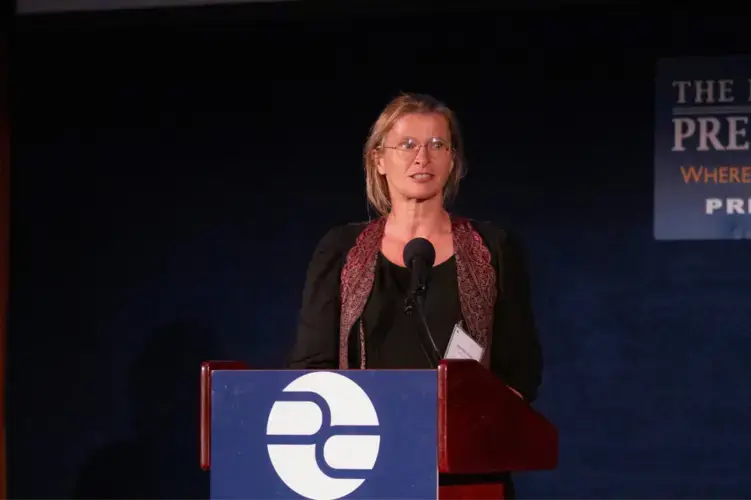
Indira Lakshmanan, executive editor of the Pulitzer Center, highlighted the editorial side of the Pulitzer Center’s mission. “Every day, editors at the Pulitzer Center have the incredible privilege to spur newsroom leaders and journalists to think bigger and to think better. We ask them, 'What untold story would you pursue if only you had the time and the financial resources?'” She added, “We award more than $2 million every year in direct support to journalism at a time of financial stress in the news industry, making possible more than 600 stories annually."
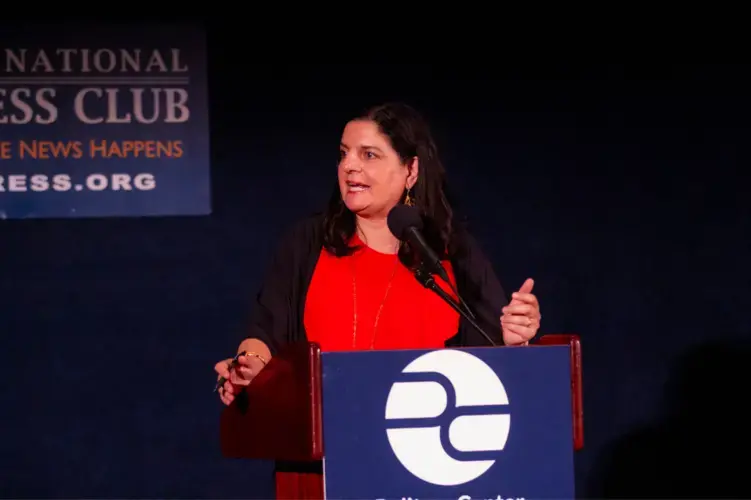
Lakshmanan introduced two journalists the Pulitzer Center supported in the last year: Phillip Martin, an investigative reporter for PRI’s The World and WGBH Boston, and Sarah Aziza, who has traveled across the Middle East and published her work in leading outlets.
“If not for the Pulitzer Center, caste discrimination in America, a five part series, would not have happened,” Martin said. The series was an exploration of casteism in South Asian communities in the United States. Martin explained that tens of thousands of Dhalits, the lowest caste members in India, have converted in the United States to Buddhism, due to a deeply embedded system of oppression. “Caste is not something you shed simply because you will it; it’s something that stays with you,” Martin said.
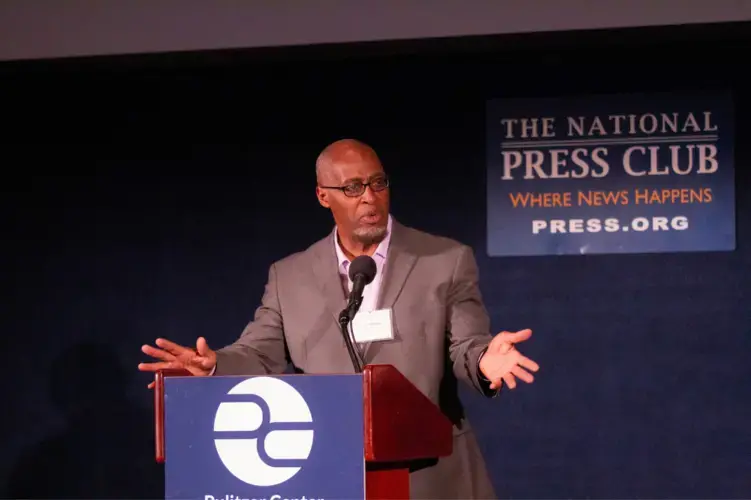
Without the Pulitzer Center, Martin may not have pursued this project. He had heard from an editor who said that the project did not have potential when two Pulitzer Center editors encouraged him to pursue the story. “That was a turning point in being able to explore an important issue in-depth,” Martin said. “We did that at WGBH, we did that at PRI’s The World, and we did that because of the Pulitzer Center,” he said.
“The Pulitzer Center has made so much of my work in the last year possible,” Aziza said. She covered the condition of women’s rights and civil liberties in Saudi Arabia at a time when the western press had been celebrating the modern Islamist policies of Crown Prince Mohammed bin Salman. “Personally unsatisfied with the reporting I saw, and outraged at the quickly executing persecution of women’s rights activists, I sought support from the Pulitzer Center to cover the darker side of this new era of Mohammed bin Salman,” she said.
“I am so grateful to share this association with the Pulitzer Center with so many world class journalists. It is my hope that the kind of intrepid journalism supported by the Pulitzer Center only continues,” she said. She reiterated the words of Jamal Khashoggi, whom she interviewed for her dispatches before his death. “I am raising my voice; to do otherwise would betray those who languish in prison. I can speak when so many cannot.”
Executive Director Jon Sawyer closed the dinner, thanking the speakers throughout the day and those who made the conference possible. “If we want these stories told, if we want our children and grandchildren to be exposed to journalism at its best, it’s up to each of us to ensure that happens. We need your support,” Sawyer said. He returned to the student at the D.C. jail who was moved by Bulaj’s photos. “We do touch lives. Those lives matter, now more than ever.”
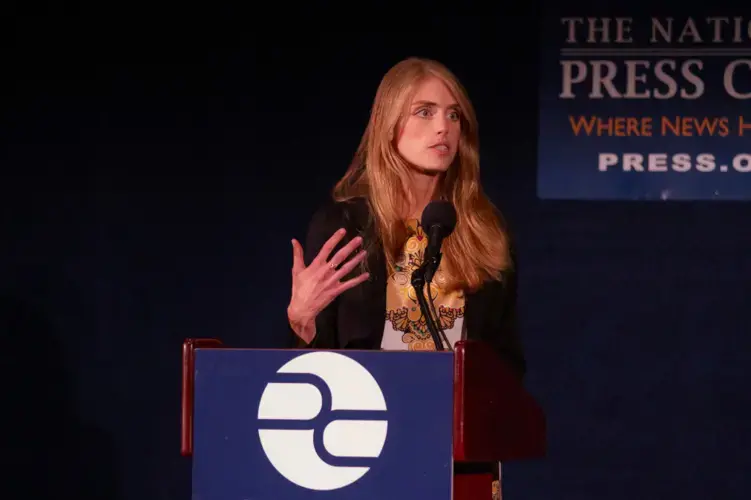
Conference attendees and panelists returned to the National Press Club on Sunday morning. In conversational workshops, they addressed the idea that religion is receding in the United States and the potential biases in media coverage of American Muslims.
The Evolution of the Religion Beat
Sections of newspapers dedicated to religion are fading away and a growing percentage of Americans identify as religiously non-affiliated. In this workshop, On Being host Krista Tippett, Tom Gjelten, NPR's Religion and Belief correspondent, and Pulitzer Center grantee Krithika Varagur described their perspectives on the evolving religion beat informed by their reporting experiences. They each emphasized the importance of taking issues of religion seriously.
Speaking of her reporting on Islam in Indonesia, Varagur said, “If you treat religion as a niche beat, something to be explained away, it’s very hard to talk to people about their ideas. Being open to people’s religious stories is indispensable if you want to work in this field.”
@pulitzercenter @PressClubDC
Poetry always rises up when official language fails us-Krista Tippett, creator and host, “On Being.”
We are now seeing a today wave of poetry and spoken word sweeping across the USA.#beyondreligion #Poetry pic.twitter.com/Ov7oAom3pn— Rachel Y Carillo (@PT4Breakfast) June 9, 2019
Deep Dive: Covering American Muslim Communities Confidently and Creatively
This workshop is part of a media training series by the Institute for Social Policy and Understanding (ISPU) to provide journalists with current, empirical research on American Muslims, enabling them to better cover American Muslim communities.
Dalia Mogahed, ISPU research director, emphasized that journalists should carefully consider what factors besides religion and culture influence and explain the behavior of Muslim individuals. “American Muslims look like every American...It’s the most diverse faith community in the United States,” she said.
For more details on the schedule and Beyond Religion conference panelists and speakers, please see the program.




